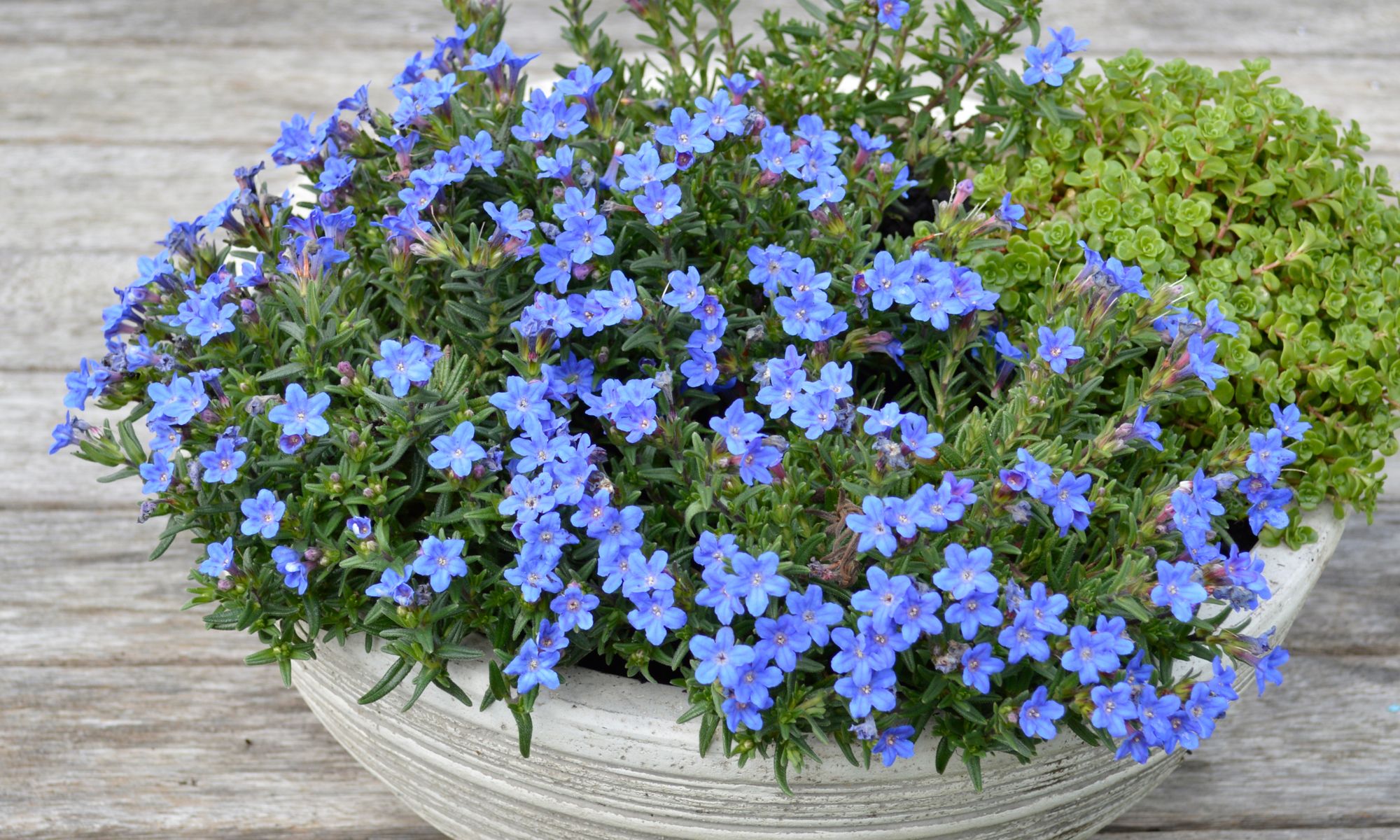A soft, colorful carpet of indigo, cyan, navy blue, pastel blue, and pale lilac plants can be created with ground cover plants that boast blue flowers. These plants serve multiple beneficial purposes in a garden landscape. They not only prevent soil erosion and suppress weeds but also cover bare patches of ground and attract pollinators.
In addition to their practical advantages, ground cover plants with blue flowers add attractive color contrasts to a landscape. The combination of blues and greens creates uncommon yet pleasing color combinations found in nature. Furthermore, these plants can enhance the foundation line of a property, provide a splash of color under shrubs, or contribute to the visual appeal of borders and mixed beds.
This article offers ideas and suggestions for selecting the finest blue-flowering ground cover plants for both front and backyard gardens. Detailed descriptions and accompanying pictures of spreading evergreens and perennial ground-hugging plants will aid in your selection process.
Superb Ground Cover Plants With Blue Flowers
Several varieties of low-growing plants with blue flowers are suitable for use as ground covers. The most effective ground cover plants are those with trailing, clumping, or creeping growth habits. These flowering plants should form a blanket of blue and green several inches tall.
Depending on the species, blue-flowering ground cover plants can thrive in full sun, partial shade, or complete shade. They are versatile enough to cover bare ground under shrubs or large trees, making them excellent options for low-maintenance landscaping. Additionally, they can be utilized to great effect in rock gardens, on slopes, or to add color and texture to borders.
Several factors should be considered when selecting the right blue-flowering ground cover plants for your landscape. Start by checking the USDA growing zone of each plant. Some mat-forming plants are classified as “evergreen perennials,” meaning they act as flowering perennials in cooler climates but retain their foliage throughout the year in warmer zones.
Sun exposure, soil type, and maintenance requirements are other key factors to take into account when choosing blue-flowering ground cover plants. Additionally, it’s crucial to assess their invasiveness, as certain spreading plants may be invasive in certain regions.
The Advantages of Planting Ground Cover Plants With Blue Flowers
The addition of ground cover plants with blue flowers can introduce a medley of pastel colors, making it easier to define and enhance various landscapes. These beautiful blooming plants create a blue carpet that elevates the visual appeal of any garden. Furthermore, ground cover plants are capable of thriving in areas where other plants struggle, making them a valuable asset. Not only do they help prevent soil erosion and control weeds, but they also add splashes of color to shaded areas in your yard.
Ground Cover Plants With Blue Flowers (Including Pictures) – An Identification Guide
Ground cover plants with blue flowers serve as an excellent way to inject a burst of color into beds, borders, and pathways. Many low-maintenance plants with trailing or creeping growth habits are equally suitable for container planting or cascading over retaining walls. Here, we present some of the finest blue ground cover plants for your garden.
Dwarf Plumbago (Ceratostigma plumbaginoides)

Dwarf plumbago is a ground cover plant with diminutive blue flowers that flourish in areas of full sun to partial shade. This low-growing perennial plant forms a mat and showcases deep blue blossoms resembling phlox flowers. Its wiry stems spread through underground rhizomes, extending up to 18” (45 cm) wide and 12” (30 cm) tall. In fall, the glossy dark green leaves transform into a bronze-red hue, adding to its visual appeal.
The small five-petalled flowers of the dwarf plumbago bloom on erect stems and measure 0.5” to 0.75” (1.2 – 2 cm) in width. These delicate blue flowers grace the plant throughout the summer until the arrival of the first frost.
Recommended USDA growing zones: 5 to 9
Bugleweed (Ajuga)

Bugleweed is an herbaceous perennial ground cover plant known for its spikes of blue flowers. Also referred to as carpet bugle or ground pine, this low-growing creeper exhibits a prostrate growth habit. Most varieties of bugleweed boast blue to purple flowers and possess small, pointed ovate leaves, some of which display shades of purple.
Recommended USDA growing zones: 4 to 9
Blue Bugle (Ajuga reptans)

Blue bugle is a shade-loving perennial ground cover plant that effortlessly spreads, boasting spikes of bluish-purple flowers. Growing up to 4” to 8” (10 – 20 cm) tall and 24” (60 cm) wide, this resilient foliage consists of small leaves forming dense rosettes in various shades of green, silver, or bronze.
Upright Bugle (Ajuga genevensis)

Also known as Geneva bugleweed, this evergreen spreading plant offers striking violet-blue flowers that grow on spikes. The blooming spikes, characterized by dense clusters of deep blue petals, reach heights between 4” and 12” (10 – 30 cm). Elongated oval leaves with smooth margins further distinguish this particular variety.
Purple Gromwell (Lithodora diffusa)
Purple gromwell is a carpet-forming perennial plant that showcases attractive lilac-blue flowers. Alongside its five-petalled blue blossoms, this ground cover plant features dark green fuzzy leaves on upright stems. Different species of spreading gromwell grow to a height of 6” (15 cm) and spread up to 24” (60 cm) wide.
Recommended USDA growing zones: 6 to 9
Lithodora diffusa ‘Grace Ward’
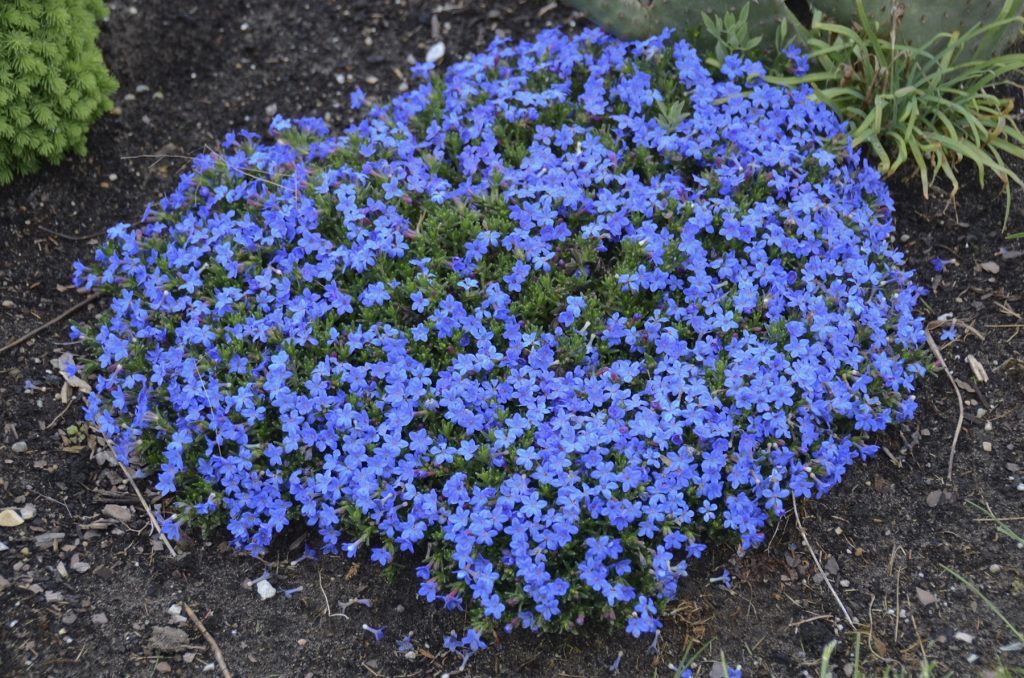
‘Grace Ward’ gromwell represents an evergreen mat-forming plant with star-shaped bright blue flowers growing atop slender spikes. This spreading shrub produces trailing stems adorned with small, narrow, dark green leaflets. The plant blooms from late spring through summer, making it a valuable addition to rock gardens or walls where it can cascade gracefully.
‘Grace Ward’ gromwell extends 36” (90 cm) wide and reaches a height of 12” (30 cm).
Lithodora diffusa ‘Heavenly Blue’

‘Heavenly Blue’ is an expansive evergreen ground cover plant known for its azure-blue funnel-shaped flowers. This gromwell cultivar boasts a prolonged flowering season. Its narrow, ovate leaves covering erect stems help distinguish it from other blue-flowering ground cover plants. It can reach a width of 18” (45 cm) and a height of 6” (15 cm).
Bellflowers (Campanula)

Bellflowers encompass a broad range of species, with many exhibiting shades of purple, blue, pink, and white. As their name suggests, bellflowers possess flowers in the shape of bells, urns, or cups. Spreading bellflowers with blue flowers typically do not grow taller than 30 cm and can spread up to 24” (60 cm).
Clump-forming bellflowers, for instance, feature clusters of drooping blue bell-shaped flowers. Other varieties may showcase light lilac-blue cup-shaped flowers or deep blue bell-like blossoms with backward curved petals.
Recommended USDA growing zones: 4 to 9
Phlox (Phlox subulata, Phlox divaricata)
Phlox is a creeping flowering plant that forms a carpet of blue, purple, pink, or white flowers. This vigorous ground cover plant boasts star-shaped, five-petalled flowers that envelop the mound-shaped foliage. Creeping phlox thrives even in poor soil conditions, making it an ideal ground cover option for areas with ample sunlight.
Two prominent species of ground cover phlox include Phlox subulata (creeping phlox) and Phlox divaricata (woodland phlox). Creeping phlox tends to have a lower height and wider spread. However, both species of blue-flowering phlox create mats adorned with fragrant pale to deep blue flowers. These creeping plants are excellent choices for rock gardens, border fronts, and ground cover purposes.
Recommended USDA growing zones: 3 to 9
Phlox subulata ‘Emerald Cushion Blue’

‘Emerald Cushion Blue’ is an appealing low-growing ground cover plant. It displays masses of star-shaped lavender-blue flowers throughout the spring season. This colorful carpet of flowers attains a height of 6” (10 cm) and spreads up to 24” (60 cm) wide.
Phlox subulata ‘Oakington Blue Eyes’
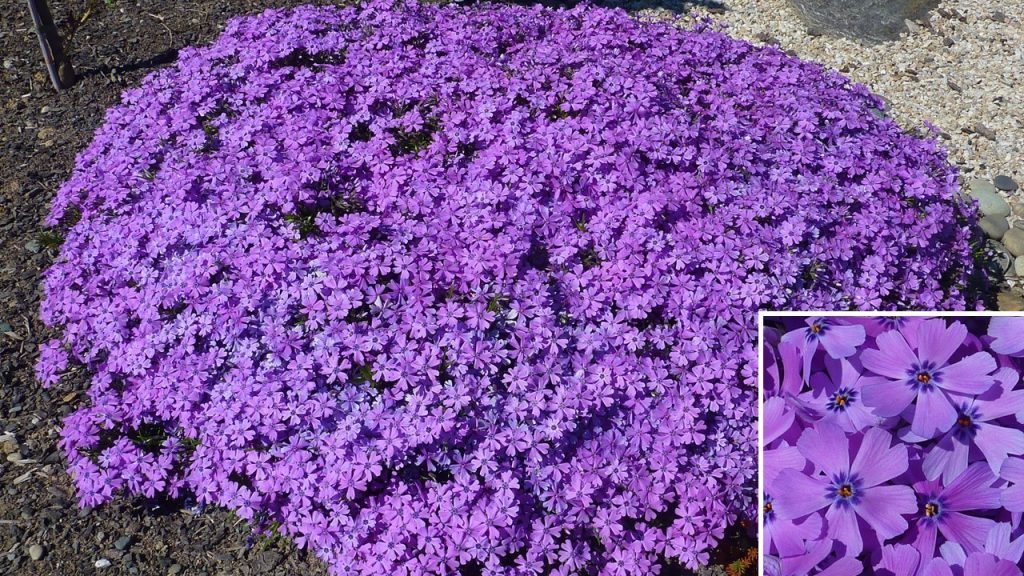
‘Oakington Blue Eyes’ showcases a low mound of pale lilac-blue flowers with dark green needle-like leaves. This vigorous creeping plant blooms in late spring and serves as an exquisite ground cover option along edges, in rock gardens, or within containers.
Wild Blue Phlox (Phlox divaricata)

Wild blue phlox, also referred to as woodland phlox, is a semi-evergreen spreading plant that produces abundant clusters of fragrant lilac-blue flowers. Its delicate star-shaped blossoms feature five spoon-shaped petals growing in clusters atop slender stems. This phlox species is particularly suitable for shade or partial shade ground cover. The flowering carpet of blue flowers reaches a height and width of 12” (30 cm).
Speedwell (Veronica prostrata)
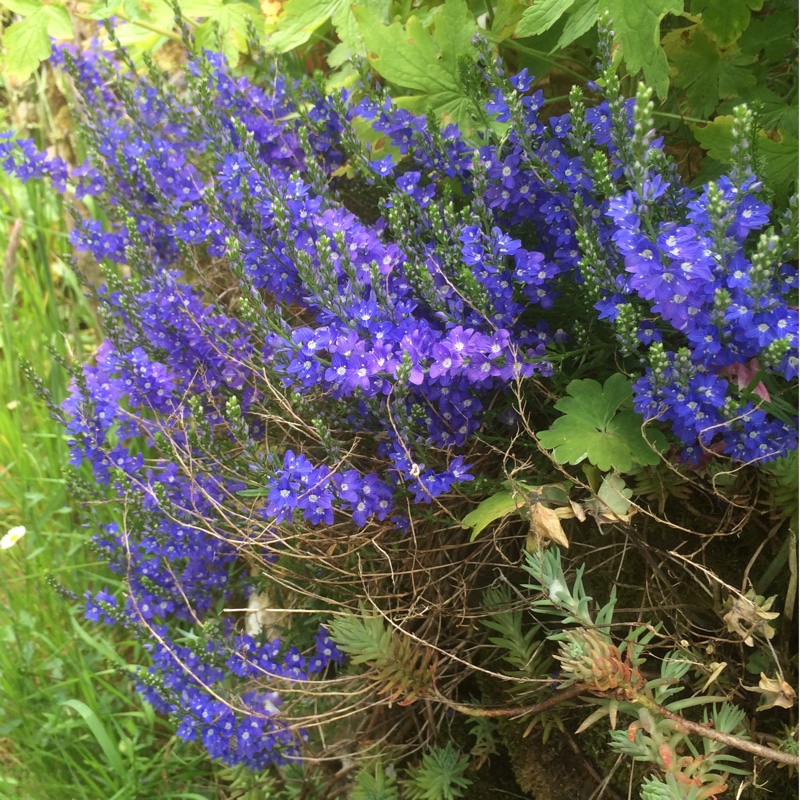
Speedwell is a beloved herbaceous perennial ground cover plant known for its ease of cultivation. Notably, this plant showcases flowering spikes with tiny blue blossoms. Furthermore, its low-spreading growth habit, lanceolate leaves, and summer blooming period contribute to its spectacular floral displays.
One noteworthy variety of speedwell is Veronica prostrata, which grows 10” (25 cm) tall and thrives in full sun to partial shade.
Recommended USDA growing zones: 4 to 8
Blue Star Creeper (Isotoma fluviatilis)

Blue star creeper is a perennial ground cover plant that forms a beautiful mat and prefers dappled sunlight or partial shade. It boasts starry soft-blue flowers that bloom throughout the summer. With its slender deep green linear leaves measuring 0.47” (1.2 cm) in length, this low-growing creeper creates a carpet of green foliage and delicate light blue flowers once established.
Blue star creeper attains a height of 2” (5 cm) and spreads up to 12” (30 cm) wide. Its versatility allows for various landscaping applications, including edging, ground cover, rock gardens, and container planting.
Recommended USDA growing zones: 6 to 8
Stemless Gentian / Trumpet Gentian (Gentiana acaulis)
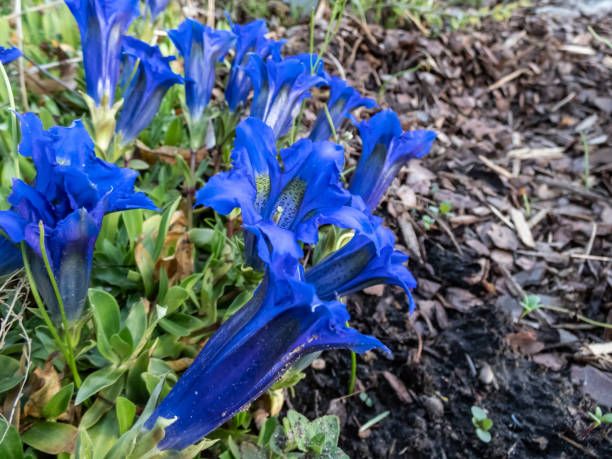
Stemless gentian is an alpine perennial ground cover plant boasting vibrant blue flowers. This low-growing plant exhibits vividly colored deep blue funnel-shaped flowers, blooming from late spring to early summer. Each trumpet-like flower features green spotted throats, adding to its decorative appeal. Dark green elliptical leaves complement the evergreen nature of this alpine perennial.
Stemless gentian grows 6” (15 cm) tall and spreads up to 12” (30 cm) wide. It thrives in sunny locations and lends itself well to edging and rock gardens, providing vibrant colors.
Recommended USDA growing zones: 3 to 7
Grape Hyacinth (genus Muscari)

Grape hyacinths are compact, low-growing plants with bell-shaped blue flowers blooming atop erect stems. When unopened, the flowering spikes resemble clusters of tiny blue berries. These long-blooming bulbous plants boast fragrant spring flowers.
Grape hyacinth reaches a height of 5” (12 cm) and spreads up to 2” (5 cm) wide. As it tends to spread rapidly, it is recommended to restrict its growth if utilizing it as a ground cover.
Recommended USDA growing zones: 4 to 8
Spanish Bluebell (Hyacinthoides hispanica)

Spanish bluebells are resilient perennials with clusters of bluish-purple bell-shaped flowers that nod gracefully on erect stems. These low-maintenance plants form clumps and propagate through bulb offsets and seeds. Their violet-blue spring flowers can reach a height of up to 18” (45 cm) and spread just as wide. Shiny, strap-shaped leaves further enhance their visual appeal.
Spanish bluebells tolerate full sun, drought, and sandy soils, making them versatile options for borders, beds, rock gardens, and containers.
Recommended USDA growing zones: 3 to 8
Lily of the Nile (Agapanthus)
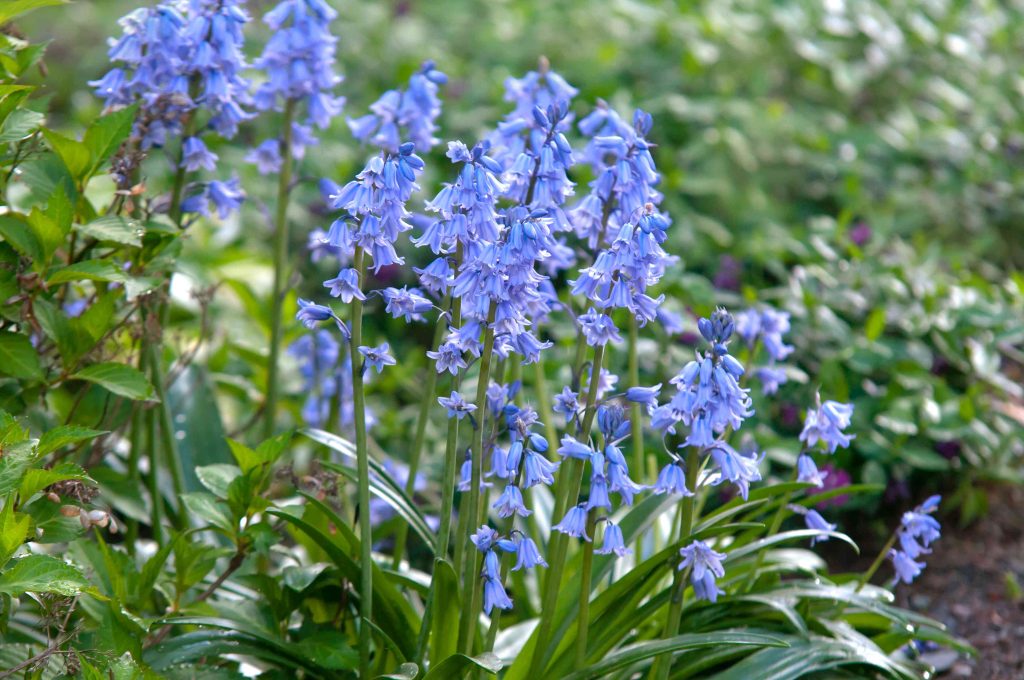
Lily of the Nile is a perennial plant that captivates with its showy purple-blue flowerhead clusters composed of small star-shaped flowers. These flowers boast delicate, linear petals in various shades of blue and purple. Round blue flower clusters develop at the ends of long, erect stems reaching heights of up to 4 ft. (1.2 m).
Lily of the Nile exhibits evergreen characteristics in warmer climates, while in colder zones, it dies back. This clumping ground cover plant spreads through fleshy rhizomes and tuberous roots.
Recommended USDA growing zones: 7 to 11
Blue Wild Indigo (Baptisia australis)
Blue wild indigo is a spreading herbaceous perennial that blooms with bright indigo flowers. Its pea-shaped blue flowers boast lipped petals, growing in clusters on long stalks. In addition to its blooming period from spring to summer, this ground cover plant features trifoliate clover-like leaves, adding to its allure.
Blue wild indigo reaches a height and width of 3 to 5 ft. (1 – 1.5 m), making it an excellent choice for mass plantings, ground cover, or as a low-growing herbaceous hedge. It thrives in full sun.
Recommended USDA growing zones: 3 to 9
Blue Dogbane / Blue Star (Amsonia tabernaemontana ‘Blue Ice’)
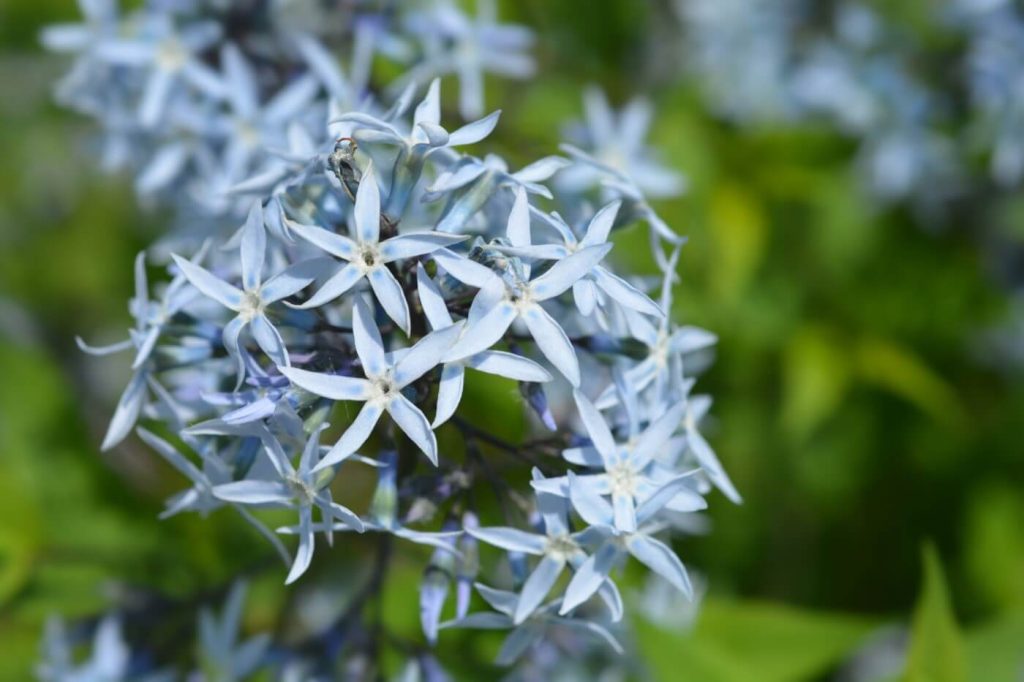
Blue dogbane ‘Blue Ice’ is an attractive and hardy ground cover plant, known for its pale blue flowers. This perennial plant forms clusters of wiry, star-shaped flowers. The flowering stems emerge from leafy stems adorned with long, pointed willow-shaped leaves. Its dense growth creates a bushy appearance, and the plant spreads to form clumps.
Mounding blue dogbane attains a height and width of 24” to 36” (60 – 90 cm). In addition to serving as an undemanding ground cover plant, it can be grown in sunny gardens, borders, or used as an accent plant. It also thrives in boggy ground, making it an ideal choice for banks.
Recommended USDA growing zones: 3 to 9
Love in a Mist (Nigella damascena)
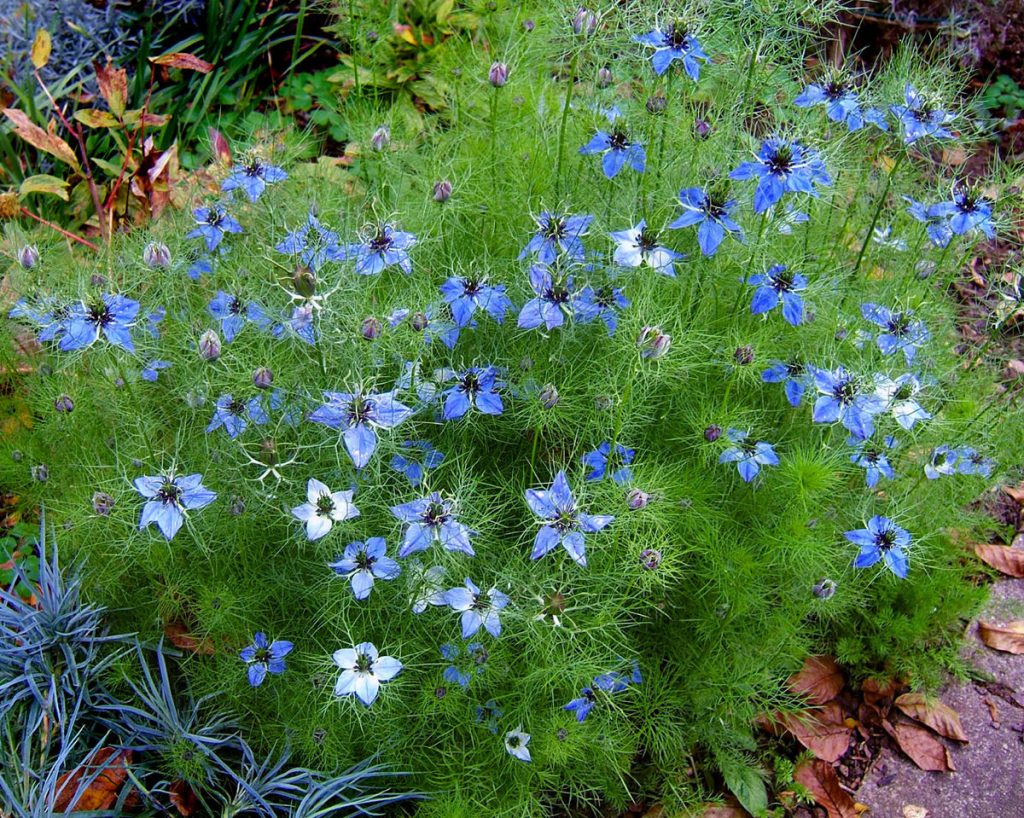
Love-in-a-mist is a bushy annual with feathery green foliage and captivating star-shaped blue flowers. Its solitary flowers measure 1” to 3” (2.5 – 7.5 cm) in diameter and boast pointed petals with wiry green stamens in the center. Love-in-a-mist is particularly popular in cool-season climates for its stunning colors.
Love-in-a-mist reaches a height of 18” to 24” (45 – 60 cm) and spreads up to 18” (45 cm) wide. In addition to its starry blue flowers, the slender needle-like leaves and balloon-shaped seed pods make it a desirable choice for dried flower arrangements.
Recommended USDA growing zones: 2 to 11
Blue Pansies (Viola)

Pansies are evergreen perennials celebrated for their remarkable array of colorful petals. Blue pansies, in particular, are stunning. Many varieties display petals with contrasting yellow patches or entirely yellow petals. Some dark blue pansies even give the impression of being black. Others exhibit pale petals with deep blue to purple centers.
Pansies are typically grown as annuals in colder climates. These low-growing plants reach heights of 3” to 10” and can spread up to 24” (60 cm) wide. Pansies are perfect for edging, mass plantings, rock gardens, and planters, adding a touch of elegance to any landscape.
